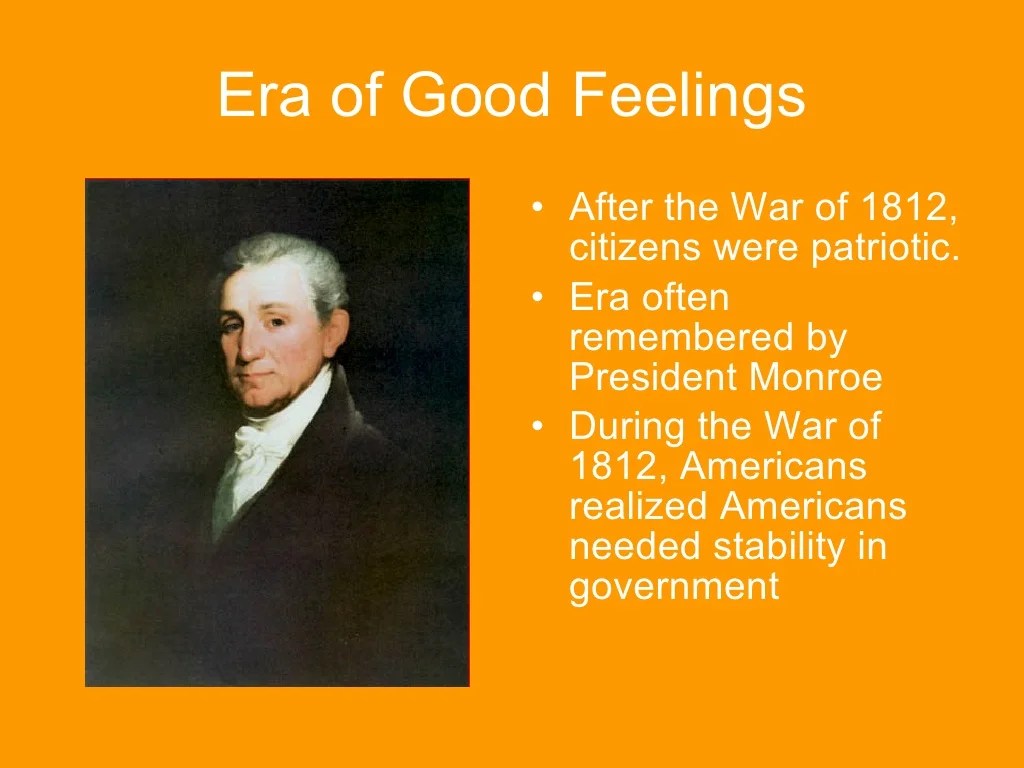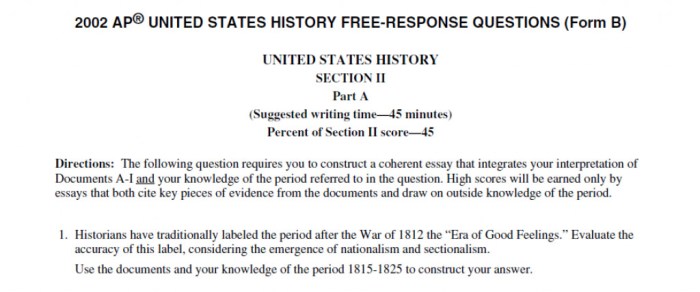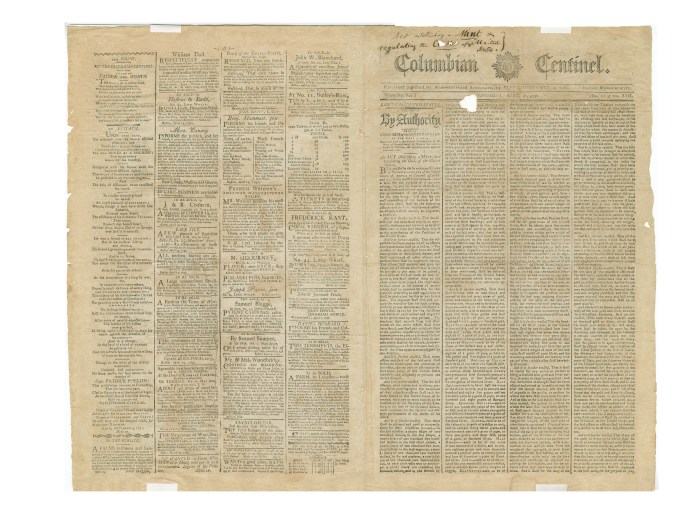Era of good feelings dbq – Embark on an enthralling journey through the Era of Good Feelings, a transformative period that witnessed America’s burgeoning identity and westward expansion. This era, marked by a surge of optimism and prosperity, left an enduring legacy on the nation’s political, economic, and social landscape.
During this era, domestic policies fostered economic growth, the Second Bank of the United States played a pivotal role, and foreign policy objectives shaped the nation’s global standing. Social and cultural changes swept across the country, fueling a sense of nationalism and American identity.
Era of Good Feelings

The Era of Good Feelings was a period of heightened national unity and optimism in the United States following the War of 1812. This period lasted from about 1815 to 1825 and was characterized by a sense of national pride and a belief in the country’s bright future.The
Era of Good Feelings was the result of several factors, including the end of the War of 1812, the expansion of the United States westward, and the rise of nationalism. The War of 1812 had been a difficult and divisive conflict, but it ultimately ended in a victory for the United States.
This victory boosted national morale and helped to create a sense of unity among Americans. The expansion of the United States westward also contributed to the Era of Good Feelings. As Americans moved west, they encountered new lands and new opportunities.
This westward expansion helped to create a sense of optimism and opportunity in the country. Finally, the rise of nationalism also played a role in the Era of Good Feelings. Nationalism is a feeling of pride and loyalty to one’s country.
During the Era of Good Feelings, Americans were proud of their country and its accomplishments. They believed that the United States was a great nation with a bright future.
Domestic Policies and Economic Developments

During the Era of Good Feelings, the United States experienced a period of relative peace and prosperity. This allowed the federal government to focus on domestic policies and economic development.One of the most important domestic policies of the era was the establishment of the Second Bank of the United States.
The bank was created to help stabilize the American economy and to promote economic growth. It did this by providing loans to businesses and individuals, and by regulating the money supply.The Second Bank of the United States played a major role in the American economy.
During the Era of Good Feelings, a period of optimism and national unity prevailed. However, this era also witnessed significant developments in healthcare, including the introduction of Virex TB and Cavi Wipes . These disinfecting wipes played a crucial role in controlling the spread of infectious diseases, further contributing to the sense of well-being and progress that characterized this era.
It helped to finance the construction of roads, canals, and other infrastructure projects. It also helped to stabilize the value of the dollar and to reduce inflation.In addition to the Second Bank of the United States, the federal government also implemented a number of other domestic policies during the Era of Good Feelings.
These policies included:
- The establishment of a national tariff to protect American industries from foreign competition.
- The creation of a system of public roads and canals to improve transportation and trade.
- The passage of laws to promote education and literacy.
These policies helped to create a more prosperous and stable American economy. They also helped to strengthen the federal government and to promote a sense of national unity.
Foreign Policy and Expansionism

The Era of Good Feelings witnessed a significant shift in American foreign policy. The United States, no longer preoccupied with the War of 1812, pursued a more assertive and expansionist approach under the leadership of President James Monroe.
Monroe Doctrine
The Monroe Doctrine, proclaimed in 1823, was a pivotal statement of American foreign policy. It declared that the United States would oppose any further colonization or interference in the Americas by European powers. This doctrine signaled a shift away from the previous policy of neutrality and established the United States as a dominant force in the Western Hemisphere.
Seminole Wars
The Seminole Wars were a series of conflicts between the United States and the Seminole people of Florida. The wars began in 1817 and lasted until 1858, as the Seminoles resisted American attempts to remove them from their lands. The wars were characterized by guerrilla warfare tactics employed by the Seminoles, and resulted in the deaths of thousands of people on both sides.
Social and Cultural Changes

The Era of Good Feelings marked a period of social and cultural transformation in the United States. Nationalism surged, fostering a sense of national identity and unity. The Market Revolution also significantly impacted American society, altering economic and social structures.
Rise of Nationalism
The War of 1812 instilled a sense of pride and patriotism among Americans. The victory over Great Britain strengthened the nation’s confidence and sparked a surge in nationalism. This sentiment was expressed through symbols like the American flag and “The Star-Spangled Banner.”
Nationalism also led to a desire for territorial expansion and the acquisition of new lands.
Growth of American Identity
The Era of Good Feelings witnessed the growth of a distinct American identity. Literature, art, and music celebrated the nation’s history and values. Authors like James Fenimore Cooper and Washington Irving wrote novels that portrayed American heroes and landscapes. Artists like John Trumbull painted historical scenes that glorified the nation’s past.
Impact of the Market Revolution, Era of good feelings dbq
The Market Revolution brought significant economic and social changes. The rise of industrialization led to the growth of cities and the emergence of a working class. The expansion of trade and commerce created new economic opportunities but also led to increased competition and economic inequality.
Political Landscape and the Rise of the Two-Party System: Era Of Good Feelings Dbq
The Era of Good Feelings, a period of relative political tranquility in the United States from 1815 to 1825, witnessed the rise of the two-party system and the decline of the Federalist Party.The Federalist Party, once the dominant force in American politics, faced increasing opposition from the Democratic-Republican Party, led by Thomas Jefferson.
The Democratic-Republicans advocated for states’ rights, a strict interpretation of the Constitution, and an expansion of democracy. The Federalists, on the other hand, favored a strong central government, a loose interpretation of the Constitution, and a more elitist approach to governance.Several
factors contributed to the decline of the Federalist Party. The party’s opposition to the War of 1812 alienated many voters, who saw the war as a defense of American honor. The party’s association with elitism and aristocracy also made it unpopular with the growing number of farmers and laborers in the United States.The
Democratic-Republican Party, on the other hand, benefited from its support for the War of 1812 and its populist appeal. The party’s commitment to states’ rights and a strict interpretation of the Constitution resonated with voters who were concerned about the growing power of the federal government.The
rise of the two-party system had a profound impact on American politics. It created a more competitive and dynamic political environment, giving voters a greater choice in who they elected. It also helped to ensure that the government was more responsive to the needs of the people.
FAQ Compilation
What were the key domestic policies implemented during the Era of Good Feelings?
Domestic policies included the establishment of a protective tariff, the creation of the Second Bank of the United States, and infrastructure development.
How did the Monroe Doctrine impact American foreign policy?
The Monroe Doctrine declared that the Americas were off-limits to European colonization, asserting American dominance in the Western Hemisphere.
What were the causes of the Seminole Wars?
The Seminole Wars were sparked by conflicts over land and the Seminole people’s resistance to removal from their traditional territories.